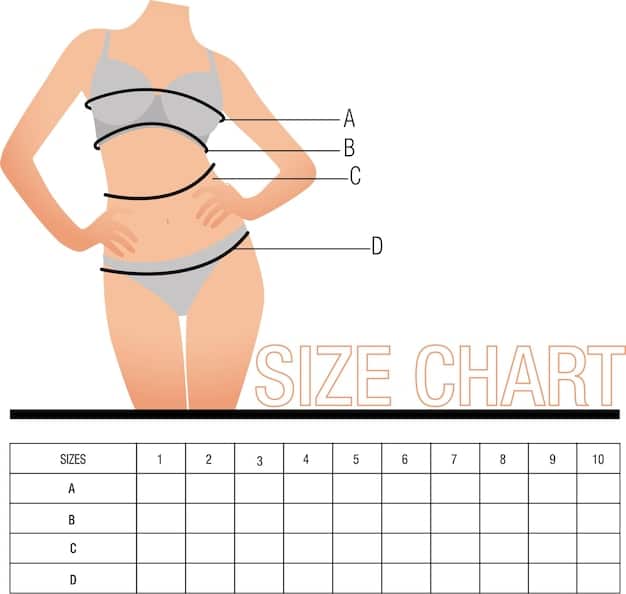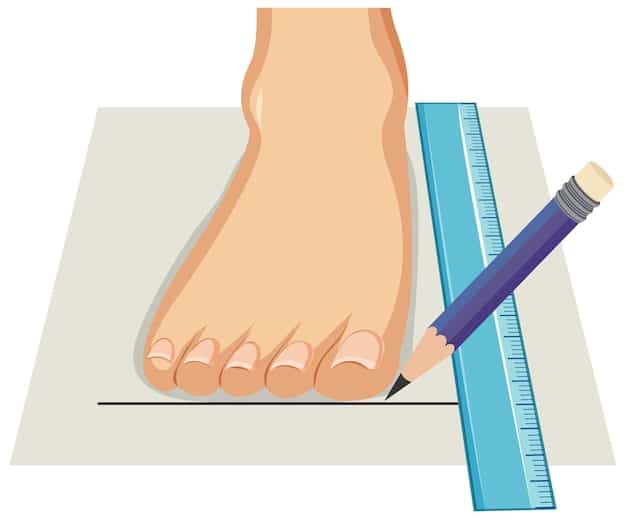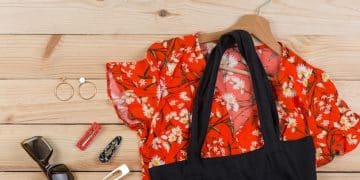Understanding Japanese Clothing Sizes: A Comprehensive Guide for US Shoppers

Navigating Japanese clothing sizes can be perplexing for US shoppers due to distinct measurement systems and differing fit philosophies, necessitating a thorough understanding of conversion charts, brand-specific variations, and the importance of accurate body measurements for a successful purchase.
Embarking on a shopping spree for Japanese fashion can be thrilling, but the journey often hits a snag when confronted with unfamiliar sizing conventions. For US shoppers, Understanding Japanese Clothing Sizes: A Comprehensive Guide for US Shoppers is not just helpful; it’s essential to avoid common pitfalls and ensure your new wardrobe additions fit perfectly.
The Fundamentals of Japanese Sizing: A Different Paradigm
Japanese clothing sizes often deviate significantly from their US equivalents, rooted in different anthropometric data and design philosophies. While US sizing generally caters to a broader range of body types, Japanese fashion frequently follows a more standardized approach, emphasizing specific proportions that may feel smaller or narrower to those accustomed to Western fits. This foundational difference is where many shoppers first encounter confusion.
It’s not merely a matter of converting inches to centimeters; rather, it’s about understanding the entire spectrum of how garments are conceptualized and cut. Japanese brands frequently offer “free size” or “one size fits all” options, particularly in more loose-fitting or oversized styles. However, even these can have underlying assumptions about the wearer’s typical measurements, so caution is advised.
Understanding the Numerical Discrepancies
Unlike the sequential numbering (e.g., 2, 4, 6) or letter grading (S, M, L) in the US, Japanese clothing sizes often start with a smaller numerical base or specific letter combinations. This can lead to a size “M” in Japan being more akin to an “XS” or “S” in the US. Moreover, the emphasis on vertical proportions, such as sleeve length or inseam, can also differ.
- Smaller Base: JP sizes often start lower (e.g., 0, 1, 2)
- Letter Inconsistency: A Japanese ‘L’ may not translate to a US ‘L’
- Height Considerations: Japanese sizing may assume shorter average heights
Furthermore, some Japanese clothes, particularly those designed for specific subcultures or aesthetic movements, might intentionally offer unconventional sizing to achieve a desired silhouette, regardless of general fit standards. Shoppers should be aware that a garment’s intended drape or oversized nature might not translate directly if the base measurements are misjudged.
Ultimately, approaching Japanese sizing requires a willingness to rethink preconceived notions of what a size label signifies. It mandates a deeper dive into the specific brand’s chart and, ideally, comparison with personal body measurements.
Key Measurements: Your Best Tool for Accurate Sizing
When delving into Japanese clothing, relying solely on letter or numerical size tags is a recipe for disappointment. The most accurate method for ensuring a good fit involves taking your precise body measurements and comparing them diligently with the brand’s size chart. This takes the guesswork out of conversion and accounts for the nuances in how garments are designed.
Before you even begin browsing, equip yourself with a flexible measuring tape. Key measurements to have on hand include your bust/chest, waist, hips, shoulder width, sleeve length, and inseam. For dresses or tops, knowing your shoulder-to-hem length can also be incredibly useful to gauge overall garment length.
Taking Your Body Measurements Correctly
Precision is paramount here. Stand naturally, not sucking in or puffing out. For bust, measure around the fullest part of your chest. For waist, find the narrowest part of your torso, typically just above your belly button. Hips should be measured around the fullest part of your derriere. Shoulder width should be taken from shoulder bone to shoulder bone across your back.
- Bust/Chest: Measure around the fullest part.
- Waist: Find the narrowest point of your torso.
- Hips: Measure around the widest part of your glutes.
- Shoulder Width: From bone to bone across the back.
- Inseam: From the crotch to the ankle.
Remember that a garment’s actual measurements will generally be slightly larger than your body measurements to allow for movement and comfort. This is known as “ease.” Japanese brands might incorporate less ease than Western brands, making the fit potentially snugger, even if the numbers appear similar.
Always cross-reference these personal measurements with the specific product’s sizing chart. Most reputable Japanese online retailers or international platforms specializing in Japanese fashion will provide detailed size charts, sometimes with both body measurements and garment measurements. Prioritize garment measurements when available for the most accurate depiction of fit.
Navigating Size Charts: Decoding Japanese Standards
Once you have your measurements, the next crucial step is deciphering the size charts provided by Japanese brands. These charts are your ultimate guide, but they can still be intimidating due to their format or the units of measurement used. Typically, Japanese size charts will list measurements in centimeters, requiring a simple but accurate conversion if you’re used to inches.
Look for charts that specify both a range of body measurements and, ideally, the actual garment measurements. Some brands might even offer guidance on how to measure yourself specifically for their clothing lines, which can be invaluable. Don’t assume consistency across different brands; a size “M” from one Japanese retailer might differ significantly from another.
Common Japanese Sizing Terminology and Units
While some charts might simply use “S, M, L,” others may employ a “numeric” system (e.g., 1, 2, 3) or more specific Japanese terms. The most common units are centimeters (cm) for length and width measurements. Weight might be listed in kilograms (kg), and height in centimeters as well.
- Units: Predominantly centimeters (cm) and kilograms (kg).
- Sizes: Often S, M, L, XL, or numeric systems (0, 1, 2, 3).
- Measurements Displayed: Bust, waist, hips, shoulder width, sleeve length, inseam, total length.
Pay close attention to measurements like “shoulder width” (肩幅 – katahaba) and “sleeve length” (袖丈 – sodetake), as these are often where the most noticeable differences arise for US shoppers. Japanese garments, especially in unisex styles, might have shorter sleeves or narrower shoulders than anticipated. For trousers, the “rise” (股上 – mataue) can also vary significantly.

When in doubt, it’s generally safer to size up when buying Japanese clothing, especially if your measurements fall between two sizes. A slightly looser fit can often be tailored, whereas a garment that is too small cannot be easily extended. Some retailers also offer specific advice on individual product pages, which should always be prioritized.
Brand Variations and Niche Styles
Just as in the US, where a size from one brand (e.g., Gap) might not perfectly match another (e.g., Zara), Japanese brands also have their unique sizing philosophies. Fast fashion giants might lean towards more flexible sizing, while high-end or niche designers could have very specific, sometimes narrower, cuts that cater to a particular aesthetic.
For instance, some “Harajuku” style clothing, known for its oversized and layered look, might intentionally be designed without strict size adherence, focusing on drape rather than a tailored fit. Conversely, minimalist Japanese brands often produce garments with very precise, clean lines that demand a more accurate fit.
Researching Brand-Specific Sizing Guides
Before making a purchase, it’s highly recommended to do a quick online search for “brand name + size chart” or “brand name + sizing review.” Many fashion blogs and forums, especially those catering to international shoppers, will offer insights and experiences with specific Japanese brands. This community knowledge can be incredibly valuable.
- Fast Fashion: May offer more forgiving fits.
- Designer Brands: Often feature precise, sometimes narrower cuts.
- Streetwear/Harajuku: Focus on oversized or intentionally loose looks.
Some brands are known for running particularly small, while others might align more closely with certain European sizing systems. Reading customer reviews can provide real-world perspectives on how garments actually fit. Look for feedback from shoppers with similar body types or measurement profiles to yours.
Ultimately, building familiarity with different Japanese brands takes time and experience. The more you explore and engage with Japanese fashion, the better you’ll become at anticipating their sizing nuances. Starting with brands known for clear sizing information or those with robust return policies can ease the learning curve.
Footwear and Accessories: Beyond Clothing
While clothing sizing conversion is often the primary concern, Japanese footwear and accessories also present their own set of unique sizing challenges. Shoe sizes, in particular, follow a completely different metric system, and understanding this is crucial for comfort and wearability. Rings, belts, and hats also have distinct sizing conventions that US shoppers should be aware of.
Japanese shoe sizes are typically measured in centimeters, corresponding to the length of the foot from heel to longest toe. This contrasts sharply with US shoe sizes, which are based on a specific, non-linear scale. A direct conversion chart is indispensable here, and even then, factors like foot width and instep height can influence fit, often requiring a slightly larger size than a direct conversion might suggest.
Japanese Shoe Sizing: Centimeters are Key
The standard Japanese shoe size directly represents the length of the foot in centimeters. For example, a size 24.5 in Japan means the shoe is designed for a foot that is 24.5 cm long. This is perhaps one of the most straightforward conversions, provided you accurately measure your foot.
- Foot Length: Measure in centimeters (cm).
- Width: Japanese shoes can be narrower; consider sizing up or looking for specific width options.
- Instep: If you have a high instep, this can also affect fit.
When measuring your foot for shoes, do so at the end of the day when your feet are at their largest. Stand on a piece of paper, trace your foot, and measure the length from the heel to the tip of your longest toe. Compare this centimeter measurement directly to the Japanese shoe size chart.

For accessories, rings are also often sized using a unique Japanese numerical system that doesn’t directly correspond to US ring sizes. Belts typically go by waist size in centimeters, and hats by head circumference. Always refer to the specific accessory’s sizing chart to ensure a correct fit. These diligent measurement checks will save you from the hassle of returns and ensure your Japanese purchases are a perfect fit from head to toe.
Returns and Exchange Policies: Your Safety Net
Despite all the precautions and careful measurements, sometimes a garment just doesn’t fit as expected. This is where understanding the return and exchange policies of Japanese retailers or international platforms is crucial. Policies can vary widely, particularly between Japanese domestic sites and those catering specifically to international shoppers.
Many Japanese online stores, especially those not primarily designed for international shipping, may have strict or complex return processes. Returns might involve significant shipping costs back to Japan, customs duties, or limited return windows. Always check the fine print regarding returns before finalizing your purchase, especially for higher-value items.
Understanding International Return Logistics
When buying directly from a Japanese website that ships internationally, familiarize yourself with their return process. Some might offer a clear English-language return guide, while others might require translation. Be aware of the timeline for initiating returns, as it’s often much shorter than in the US.
- Shipping Costs: Often borne by the buyer for international returns.
- Customs Duties: Can complicate returns or refunds.
- Return Window: Frequently shorter than US domestic policies.
Purchasing from international platforms that stock Japanese brands (e.g., specific sections on major fashion retailers or dedicated Japanese fashion e-commerce sites) can often streamline the return process, as they typically have policies more familiar to US consumers. These platforms might absorb some of the international shipping costs or offer local return addresses.
If you’re buying from a seller on a marketplace, check their individual return policy, which may differ from the platform’s general policy. Given the potential complexities and costs involved, the emphasis should always be on getting the size right the first time. However, knowing your options for returns provides a valuable safety net and peace of mind.
Tips for a Seamless Japanese Shopping Experience
Beyond concrete sizing conversions, several best practices can elevate your overall Japanese clothing shopping experience. These tips are designed to minimize surprises and maximize the joy of acquiring truly unique and stylish pieces from across the globe, ensuring that your Understanding Japanese Clothing Sizes: A Comprehensive Guide for US Shoppers pays off.
First, patience is key. Don’t rush into purchases. Take the time to measure, consult charts, and read reviews. Second, embrace the aesthetic. Japanese fashion often has a distinct proportion and silhouette; appreciating this can help you anticipate how garments will drape and fit, even if the absolute measurements seem slightly off by Western standards.
Leveraging Community and Visual Resources
Many online communities, such as Reddit forums (e.g., r/malefashionadvice, r/femalefashionadvice, or dedicated streetwear subreddits), have extensive discussions on Japanese sizing. Searching for specific brand names or styles there can yield valuable insights from other international shoppers. Visual resources are also incredibly helpful.
- Watch Unboxing Videos: See how garments look on real people with varying body types.
- Check Model Measurements: Many product pages list the model’s height and the size they are wearing.
- Seek Out Reviews with Photos: Visual feedback from other buyers can be invaluable.
Consider looking for photos of real people wearing the specific item you’re interested in, perhaps on social media or review sites. This can give you a better sense of how the garment truly fits and looks on a human body rather than just a flat image. Also, comparing the model’s measurements and the size they are wearing can be a useful benchmark, assuming the retailer provides this information.
Lastly, recognize that Japanese fashion can be experimental with fit. Some items are intentionally oversized or uniquely structured. Understanding this design intent can help you appreciate the garment even if it doesn’t fit your body exactly as a Western equivalent might. Ultimately, the goal is to enjoy the unique style and quality of Japanese clothing with confidence in your sizing choices.
| Key Takeaway | Brief Description |
|---|---|
| 📏 Measure Yourself Accurately | Prioritize precise body measurements (cm) over letter sizes for best fit. |
| 📊 Decode Size Charts | Always consult brand-specific charts; assume CM is the default unit. |
| 👟 Footwear & Accessories | Japanese shoe sizes are in cm; measure foot length directly. |
| 🔍 Research Brand Variance | Sizes differ between brands; check reviews and community insights. |
Frequently Asked Questions About Japanese Clothing Sizes
Japanese clothing sizes are often smaller primarily due to differences in average body anthropometrics. Japanese populations generally have a smaller stature and narrower builds compared to typical US body types. Additionally, design philosophies may favor slimmer silhouettes, meaning garments are cut with less allowance or “ease” for movement and comfort compared to Western clothing.
The most accurate method is to disregard direct letter (S, M, L) or numerical US-to-Japanese conversions. Instead, take your precise body measurements (bust, waist, hips, shoulder width, sleeve length, inseam) in centimeters and compare them directly to the specific brand’s size chart. This accounts for unique cut and fit variations that traditional conversion charts can’t.
No, just like in the US, sizing can vary significantly among different Japanese brands. Fast fashion retailers might have more forgiving fits, while high-end or niche designers could have very specific, tailored cuts. Always consult the individual size chart provided by each specific brand or retailer for the most accurate information on a particular garment.
Japanese shoe sizes are typically listed in centimeters, which directly corresponds to the length of the foot. For example, a Japanese size 24.5 is for a foot that is 24.5 cm long. This is a direct measurement, unlike the non-linear US shoe sizing system. Always measure your foot length in centimeters and refer to a Japanese shoe size conversion chart.
If your measurements fall between two sizes on a Japanese size chart, it is generally safer to size up. Japanese garments tend to be cut narrower and with less ease. Choosing the larger size will likely provide a more comfortable fit and reduce the risk of the item being too tight. A slightly looser fit can often be managed, but a too-small garment is unwearable.
Conclusion: Mastering Japanese Fashion with Confidence
Navigating the intricacies of Japanese clothing sizes as a US shopper might seem daunting initially, but with a strategic approach, it becomes an empowering experience. The core takeaway lies in prioritizing precise body measurements in centimeters, diligently consulting brand-specific size charts, and recognizing the unique design philosophies that shape Japanese fashion. By understanding that Japanese sizing isn’t a direct conversion but rather a distinct system, you unlock the ability to confidently explore a world of unique styles and high-quality garments. Embrace the measuring tape, research your preferred brands, and prepare to elevate your wardrobe with perfectly fitting pieces from Japan.





